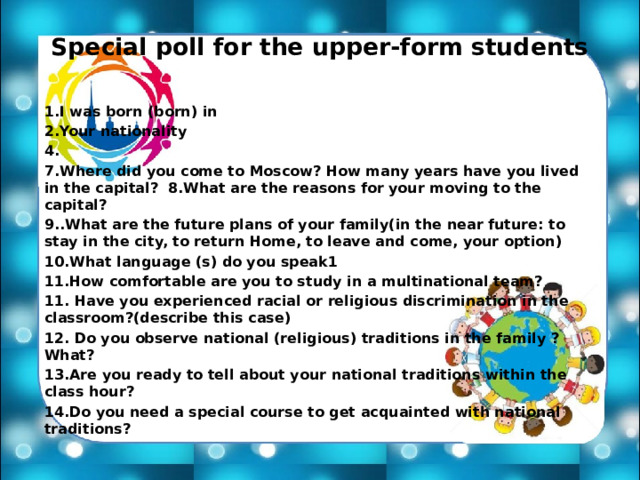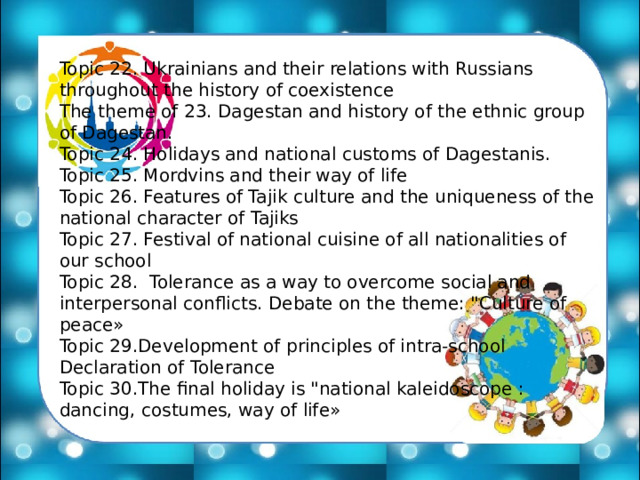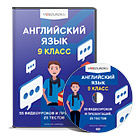
«On the road to globalization: tolerance within a small group as the key to bondary-spannig»
Supervisor: Olga Peshcherskaya

Novelty and topicality
)

Topicality and novelty
Actuality: this topic is relevant because the process of increasing the number of migrants who join the indigenous population of megacities annually, a regular process in terms of urbanization. In connection with the constant growth of migrants, it is important to develop the principles of tolerant coexistence.
Novelty: our project is developed at the junction of several fundamentals (ethnogeography, sociology, social science, statistics, cultural studies, ethics and psychology)

Total number of migrants in Russia

Our goal
To study the ethnic composition of upper-form students (9-11)in the metropolis of experimentally proving that the socio-cultural, religious and language differences contribute to the convergence and blurring of clear boundaries between cultures and are the objective conditions for the formation of a new generation of teenagers ready to live in the terms of globalization

Our tasks :
- Identify the sources of information and select the necessary information for the theoretical part of the project
- To conduct research through questionnaires and interviews and to identify the ethnogeographic, religious and linguistic range of nationalities (ethnic groups) among high school students
- To name the main reasons for the migration of families to megacities and to assess the comfort of training and existence in a multinational team for migrants
- Conduct interviews with representatives of different ethnic groups in order to identify the level of knowledge of traditions and customs of different peoples
- Summarize the results of the survey in a comparative table and chart system

Hypothesis
To prove the necessity of development and implementation of a special course “Unity in diversity!” aimed at instilling a tolerant attitude to different ethnic groups within a small group through the study and creation of common traditions and keeping their own customs up on the basis of universal human values

Subject and object of the project
Object of research: ethnogeographic composition of high school students of our school
Subject of research: the process of merging, mutual influence and interaction of different ethnic groups on each other within a small group

Practical output

Practical output:
- This project provides an opportunity to consider one particular group as a typical small group in a metropolis and to develop the principles and rules of its comfortable existence.
- To compile a series of illustrated booklets providing information on ethnic minorities and their culture3.
- Offer practical advice to teachers on working in multinational teams and develop an elective course “Unity in diversity!”

Guide to the project
- Introduction 1.Methodological characteristics: Purpose, objectives Relevance + novelty, Hypothesis Method of research
- Introduction
- 1.Methodological characteristics:
- Purpose, objectives
- Relevance + novelty,
- Hypothesis
- Method of research
2.Theoretical part of the project (descriptive):
Determination of the main ethno-geographical concepts
Main types and causes of migration
Difficulties of adaptation of migrants Conclusion on the theoretical part
3.Practical part:
Questionnaire survey of high school students
Interviewing representatives of different ethnic groups
Creation of a series of illustrated booklets on ethnic minorities and their culture
Creating a special course " we are different and this is our strength!»4.The conclusions of the project.
5.Applications.
6Bibliography


Migration of the population is called a change of residence, moving from one city to another, abroad.
Types of migration:
- Permanent
- Temporary
- Seasonal
- Pendular
- Episodic.
Types of internal migration :
- village-village
- village-city
- city-city.

Types of migration
- Economic
- Political
- Religious
Outside migrations: immigration, emigration, remigration
Inside migrations: inter-district migrations, village-city, reverse migration

CAUSES OF MIGRATION
Причины миграции
National
ECOLOGICAL
Economic
RELIGIOUS
REASONS OF
MIGRATION
POLITICAL
People leave their places of living for unknown ones in order to change their lives for the better or escape from local conflicts, poverty or national and religious persecution

Adaptation difficulties of migrants
Xenophobia-rejection of foreigners, people who carry not only new knowledge and experience, but also certain stereotypes, as well as their own vision of the world.
The problem of adaptation-language barrier, ignorance of mentality, loneliness
Exceeding the permissible threshold of migrants-exceeding the threshold of tolerance of the owners
Non-participation of migrants in the life of the country: has no opportunity in a short time to feel the culture, life, traditions and remains an observer of all social processes
The absence of the usual environment causes a constant sense of moral discomfort as a migrant changes his / her country of residence, lifestyle, habits, worldview and even language.



Internal migration changes the composition of any social groups, turning them into an international team Внутренняя миграция меняет
Without the formation of tolerance , respect for other peoples and the development of common principles of coexistence, the normal equilibrium existence of any small group in a metropolis is impossible
Any manifestations of national discrimination and xenophobia will lead to conflicts and disunity of the team and would prevent the implementation of the objectives
The science of coexistence, cooperation with mutual respect and tolerance is the first step towards globalization, first within a mini-group and then in a global sense

Practical part
- Survey of high school students to identify the ethnographic composition of the students
- Creation of a series of illustrated booklets providing information on ethnic minorities and their culture
- Development of the elective course " we are different and this is our strength! On the way to tolerance»

Special poll for the upper-form students
1.I was born (born) in
2.Your nationality
4.
7.Where did you come to Moscow? How many years have you lived in the capital? 8.What are the reasons for your moving to the capital?
9..What are the future plans of your family(in the near future: to stay in the city, to return Home, to leave and come, your option)
10.What language (s) do you speak1
11.How comfortable are you to study in a multinational team?
11. Have you experienced racial or religious discrimination in the classroom?(describe this case)
12. Do you observe national (religious) traditions in the family ? What?
13.Are you ready to tell about your national traditions within the class hour?
14.Do you need a special course to get acquainted with national traditions?


Other representatives of national minorities
Kurds (Yazidis) 2
Georgians 3
Uzbeks 3
Concealed their nationality7
Tuvans 2
Germans 3


Have you faced any type of discrimination at school?
I faced or was a witness of it
Never came across
Из 61 человека столкнулось 66% , соответственно 34% не столкнулось
23

Principal types of discrimination
National discrimination 50%
Religious discrimination 15%
Sexism/ageism 5%
Harassment, bullying 30%

How tolerant are you?
I am tolerant
I can be intolerant

Does our school need a special elective course to struggle with discrimination ?

Results of our poll
- Most students in our school have experienced discrimination.
- The most common forms of discrimination are national and religious discrimination.
- Some students were honest enough to call themselves non-tolerant people
- In General, our surveys have shown that this topic is extremely controversial and deserves discussion and decision at the local and state level

In-between conclusion
- On the basis of these diagrams we have come to the conclusion that the number of Russian students considerably prevails, but at the same time we observe a variety of representatives of other ethnic groups and nationalities who will have to interact and exist in the conditions of a small group
- Due to the occurrence of cases of intolerance and even discrimination is relevant to work at school in this direction
- Ethnic diversity is a characteristic feature of all modern megapolicies

Ethnic mosaic of our school: Armenians as a nation
Be decent and tolerant and that
a diverse community is a strong community.

Calling card of our special booklets
.Geographical location( capital)
2.A brief historical digression
2. Political structure and state symbols
3.Economic sector
4.Flora and fauna
3. Features of culture (music/architecture/painting/literature/national cuisine)
4. Landmarks
5.Famous people
6.National holidays and religion
7.Features of the national character
8.General conclusion
Next year we think we will make a multimedia application for this course and translate the booklets in English

Elective course- " We are different and this is our strength! On the way to tolerance»
The purpose of the course: the program of interdisciplinary elective course is aimed at deepening and expanding knowledge and skills in the subjects of history and social science which open up significant opportunities for the disclosure of the essence of tolerance and its place in the development of human civilization and create a practical field for the formation of a tolerant consciousness of students to understand their personal experience of tolerant behavior in life. The course is designed for 30 hours.

Course tasks:
- education of students in the spirit of openness and understanding of other peoples, diversity of cultures and history, education of students in the spirit of a Culture of peace, i.e. understanding that the level of development of mankind, its material and spiritual culture is a culture of peace, which allows you to build relationships between people without resorting to methods of violence;
- promote the principles of cooperation and training in the non-violent resolution of conflicts; training in the use of peaceful means to resolve differences;
- clarification of the fact that the Russian state was formed and developed as a result of the interaction of the peoples living in it;
- formation of the understanding that Russia as a state exists due to multinational diversity.

Course content
Topic 1. Basic principles of tolerance. What is tolerance?
Topic 2 . Religious consciousness and tolerance.
Topic 3. Awareness of the law and tolerant behavior.
Topic 4. Tolerance as a way to overcome social and interpersonal conflicts.
Topic 5. Diversity of the modern world. Representation of ethno-geographical mosaics of the seniors of our school. Familiarity with the content of the course.
Topic 6. Familiarity with the cultural traditions and customs of Russian.
Topic 7. Introduction and features of national character of Russians . Topic 8. Visit the "Museum of history of Moscow»

Topic 9. Visit to the Museum " Museum of decorative, applied and folk art in Moscow»
Topic 10. The origins and way of life of the Jews.
Topic 11. Visit to the Museum " Jewish Museum and tolerance Center in Moscow»
Topic 12.Jewish traditions, holidays and peculiarities of mentality.
Topic 13. Tatars and their customs. History Of Tatarstan.
Topic 14.Tatar holidays and some features of the national character.
Topic 15.Armenians and their contribution to world culture.
Topic 16. National holidays of Armenians and their cultural traditions.
Topic 17. Azerbaijanis and their national customs today.
Topic 18. National holidays of Azerbaijanis and peculiarities of mentality.
Topic 19. Visit to the Museum State Museum of Oriental art»
Topic 20. A brief excursion into Chechen culture and history.
The theme of 21. Features of cultural life of Chechens

Topic 22. Ukrainians and their relations with Russians throughout the history of coexistence
The theme of 23. Dagestan and history of the ethnic group of Dagestan.
Topic 24. Holidays and national customs of Dagestanis.
Topic 25. Mordvins and their way of life
Topic 26. Features of Tajik culture and the uniqueness of the national character of Tajiks
Topic 27. Festival of national cuisine of all nationalities of our school
Topic 28. Tolerance as a way to overcome social and interpersonal conflicts. Debate on the theme: "Culture of peace»
Topic 29.Development of principles of intra-school Declaration of Tolerance
Topic 30.The final holiday is "national kaleidoscope : dancing, costumes, way of life»

General conclusion
Based on our research , we have come to the conclusion that a comfortable coexistence in a metropolis for any small group is possible if, learning the traditions of other peoples and preserving our own customs, we bring up a tolerant attitude towards each other on the way to globalization.

TOLERANCE IS THE KEY TO WORLD PEACE!

 Получите свидетельство
Получите свидетельство Вход
Вход












 On the road to globalization: tolerance within a small group as the key to bondary-spannig (4.35 MB)
On the road to globalization: tolerance within a small group as the key to bondary-spannig (4.35 MB)
 0
0 289
289 0
0 Нравится
0
Нравится
0



